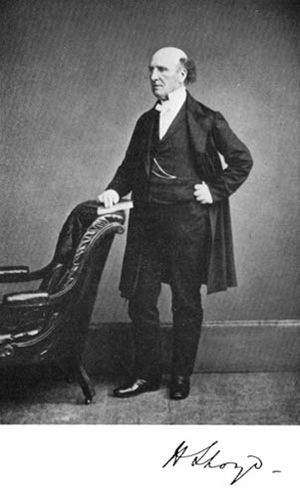Humphrey Lloyd (physicist) facts for kids
Quick facts for kids
Humphrey Lloyd
|
|
|---|---|

Humphrey Lloyd
|
|
| Born | 16 April 1800 |
| Died | 17 January 1881 (aged 80) |
| Known for | Lloyd's mirror |
| Awards | Pour le Mérite for Sciences and Arts (1874) Cunningham Medal (1862) Fellow of the Royal Society (1836) |
| Scientific career | |
| Fields | Physicist |
Humphrey Lloyd (1800–1881) was an important Irish physicist. He taught at Trinity College Dublin as the Erasmus Smith's Professor of Natural and Experimental Philosophy from 1831 to 1843. Later, he became the Provost (leader) of the college from 1867 to 1881.
Lloyd is famous for proving something called conical refraction. This was a theory by William Rowan Hamilton about how light bends when it goes through certain types of crystals. Lloyd was also a member of the Royal Society, a very respected scientific group. He also led the British Association and the Royal Irish Academy.
Contents
Early Life and Education
Humphrey Lloyd was born in Dublin, Ireland, on April 16, 1800. His father, Bartholomew Lloyd, was also a professor and later the Provost of Trinity College Dublin.
Humphrey went to Mr. White's school in Dublin. In 1815, he started at Trinity College Dublin. He was the top student out of 63 people who took the entrance exam. He became a Scholar in 1818 and earned his first degree (B.A.) in 1819. He was first in science and won a gold medal. He continued his studies, getting his M.A. in 1827 and D.D. in 1840. He became a junior fellow at the college in 1824 and a senior fellow in 1843.
Scientific Discoveries
In 1831, Lloyd took over his father's role as the Erasmus Smith's Professor of Natural and Experimental Philosophy. At a meeting of the British Association in 1833, he shared his exciting discovery. He had proven through experiments that conical refraction really existed in certain crystals. This matched the theory that William Rowan Hamilton had suggested.
Lloyd also figured out how the polarization of light works in these crystals. Polarization is about how light waves vibrate. Soon after, he did another experiment using something called a Lloyd's mirror. This experiment helped us understand more about how light behaves when it reflects off surfaces. He also studied how light interacts with very thin materials.
Studying Earth's Magnetism
Lloyd also played a big part in studying terrestrial magnetism. This is the Earth's natural magnetic field. When a special magnetic observatory was set up at Trinity College Dublin, Lloyd was put in charge. He designed the tools and watched over their creation.
He was part of a group that pushed the government to learn more about Earth's magnetism. He wrote instructions for the observatories and trained the scientists who would work there.
Later Life and Leadership
From 1846 to 1851, Lloyd was the president of the Royal Irish Academy. This group gave him their Cunningham gold medal in 1862 for his scientific work. He stopped being a professor in 1843 when he became a senior fellow at Trinity College.
In 1862, he became the vice-provost, and in 1867, he was chosen to be the Provost of the college. This was a very important leadership role. In 1857, he was the president of the British Association when they met in Dublin. He gave a speech about the latest discoveries in astronomy and Earth's magnetism.
Humphrey Lloyd passed away in Dublin on January 17, 1881.
Awards and Recognition
Lloyd received many honors for his contributions to science. He was a member of the Royal Societies of London and Edinburgh. He was also an honorary member of many other scientific groups in Europe and America. In 1839, he became a member of the American Philosophical Society.
In 1855, the University of Oxford gave him an honorary degree (D.C.L.). In 1874, the emperor of Germany awarded him the prestigious Pour le Mérite award. A statue of him, created by Albert Bruce Joy, was placed in the library of Trinity College in 1892 to remember his achievements.
Images for kids


